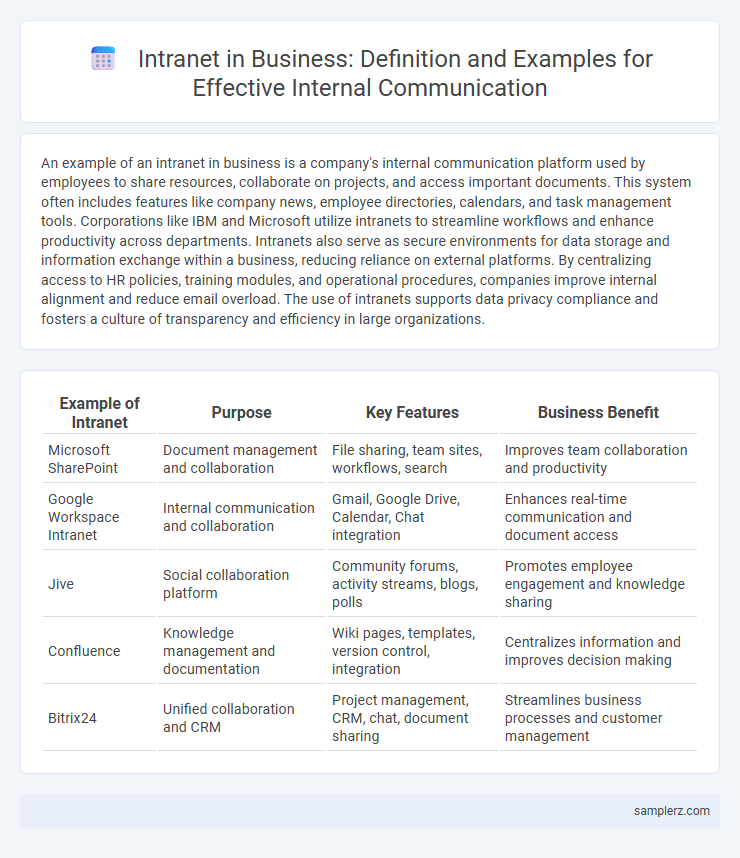An example of an intranet in business is a company's internal communication platform used by employees to share resources, collaborate on projects, and access important documents. This system often includes features like company news, employee directories, calendars, and task management tools. Corporations like IBM and Microsoft utilize intranets to streamline workflows and enhance productivity across departments. Intranets also serve as secure environments for data storage and information exchange within a business, reducing reliance on external platforms. By centralizing access to HR policies, training modules, and operational procedures, companies improve internal alignment and reduce email overload. The use of intranets supports data privacy compliance and fosters a culture of transparency and efficiency in large organizations.
Table of Comparison
| Example of Intranet | Purpose | Key Features | Business Benefit |
|---|---|---|---|
| Microsoft SharePoint | Document management and collaboration | File sharing, team sites, workflows, search | Improves team collaboration and productivity |
| Google Workspace Intranet | Internal communication and collaboration | Gmail, Google Drive, Calendar, Chat integration | Enhances real-time communication and document access |
| Jive | Social collaboration platform | Community forums, activity streams, blogs, polls | Promotes employee engagement and knowledge sharing |
| Confluence | Knowledge management and documentation | Wiki pages, templates, version control, integration | Centralizes information and improves decision making |
| Bitrix24 | Unified collaboration and CRM | Project management, CRM, chat, document sharing | Streamlines business processes and customer management |
Introduction to Intranet in Business
An intranet in business serves as a secure internal network that facilitates communication, collaboration, and information sharing among employees within an organization. Examples include platforms like Microsoft SharePoint, which streamlines document management and project coordination, and Slack, enhancing real-time messaging and teamwork. These intranet solutions improve operational efficiency by centralizing resources and enabling seamless employee engagement.
Key Features of Business Intranet Platforms
Business intranet platforms typically include key features such as centralized document management, real-time collaboration tools, and integrated communication channels like instant messaging and discussion forums. These platforms also offer customizable dashboards, advanced search capabilities, and secure access controls to enhance productivity and information sharing within an organization. Employee directories and project management modules further streamline workflows and promote efficient internal communication.
Enhancing Collaboration with Intranet Examples
In business, intranet platforms like Microsoft SharePoint and Slack enhance collaboration by providing centralized spaces for document sharing, real-time communication, and project management. These intranet examples streamline workflows, improve information accessibility, and foster team engagement across departments. Companies leveraging these tools report increased productivity and faster decision-making processes.
Streamlining Internal Communication via Intranet
Implementing an intranet platform like Microsoft SharePoint streamlines internal communication by centralizing company updates, project collaboration, and document sharing within a secure environment. Streamlined communication through an intranet reduces email overload and accelerates decision-making processes by providing real-time access to critical information. Organizations experience enhanced employee engagement and productivity as teams seamlessly connect across departments and locations.
Document Management Solutions on Intranet
Document Management Solutions on intranets streamline the organization, storage, and retrieval of critical business documents, enhancing collaboration across departments. These systems support version control, access permissions, and real-time editing, ensuring document integrity and security. Integrating DMS with intranet portals boosts productivity by centralizing resources and facilitating compliance with regulatory requirements.
Employee Onboarding through Intranet Systems
Employee onboarding through intranet systems streamlines the integration process by providing centralized access to training materials, company policies, and communication tools. This approach enhances new hire productivity by enabling self-paced learning and immediate connection with mentors and HR resources. Companies utilizing platforms like SharePoint or Jive intranet experience accelerated onboarding timelines and improved employee engagement.
Improving Knowledge Sharing on Intranet
Implementing a centralized intranet platform like Microsoft SharePoint significantly enhances knowledge sharing by providing employees with seamless access to company resources, project updates, and collaborative tools. Integrating features such as discussion forums, document libraries, and real-time editing fosters efficient communication and reduces information silos across departments. Analytics dashboards embedded within the intranet help track content usage and identify key knowledge contributors, further optimizing information flow and decision-making.
Real-World Case Studies of Business Intranet
Siemens implemented an intranet platform to streamline internal communication and improve knowledge sharing across its global offices, resulting in a 20% increase in employee productivity. Deloitte's use of a customized intranet system enhanced collaboration among its consulting teams, reducing project completion times by 15%. Microsoft's corporate intranet integrates advanced search functions and social networking features, fostering innovation and accelerating decision-making processes.
Measuring Intranet Success in Organizations
Measuring intranet success in organizations involves tracking user engagement metrics such as page views, active users, and time spent on key content. Employee satisfaction surveys and feedback tools provide qualitative insights into intranet usability and impact on collaboration. Integration of advanced analytics platforms enables businesses to identify adoption trends and areas for continuous improvement.
Future Trends of Intranet in Modern Business
Future trends of intranet in modern business emphasize AI-powered personalization, enabling tailored content delivery and enhanced employee engagement. Integration with collaboration tools like Microsoft Teams and Slack streamlines communication, while advanced analytics provide insights into user behavior and productivity. Cloud-based intranets promote remote work flexibility and seamless access to corporate resources from any device or location.

example of intranet in business Infographic
 samplerz.com
samplerz.com